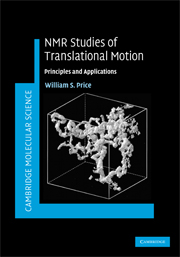Book contents
- Frontmatter
- Contents
- Preface
- Acknowledgements
- Abbreviations
- 1 Diffusion and its measurement
- 2 Theory of NMR diffusion and flow measurements
- 3 PGSE measurements in simple porous systems
- 4 PGSE measurements in complex and exchanging systems
- 5 PGSE hardware
- 6 Setup and analysis of PGSE experiments
- 7 PGSE hardware and sample problems
- 8 Specialised PGSE and related techniques
- 9 NMR imaging studies of translational motion
- 10 B1 gradient methods
- 11 Applications
- Appendix
- Index
Preface
Published online by Cambridge University Press: 06 August 2010
- Frontmatter
- Contents
- Preface
- Acknowledgements
- Abbreviations
- 1 Diffusion and its measurement
- 2 Theory of NMR diffusion and flow measurements
- 3 PGSE measurements in simple porous systems
- 4 PGSE measurements in complex and exchanging systems
- 5 PGSE hardware
- 6 Setup and analysis of PGSE experiments
- 7 PGSE hardware and sample problems
- 8 Specialised PGSE and related techniques
- 9 NMR imaging studies of translational motion
- 10 B1 gradient methods
- 11 Applications
- Appendix
- Index
Summary
Translational motion in solution (e.g., diffusion, flow or advection) plays a central role in science. Self-diffusion can be rightfully considered as being the most fundamental form of transport at the molecular level and, consequently, it lies at the heart of many chemical reactions and can even govern the kinetics. Diffusion, due to its very ubiquity, is encountered in a myriad of scientific studies ranging from diseases to separation science and nanotechnology. Further, the translational motion of a species not only reflects intrinsic properties of the species itself (e.g., hydrodynamics), but can also shed light on the surrounding environment (e.g., intermolecular dynamics or motional restriction). Consequently, being able to study and ultimately understand the translational motion of molecules and molecular systems in their native environment is of inestimable scientific value.
Measuring translational motion at the molecular level presents special difficulties since labelling (e.g., radiotracers) or the introduction of thermodynamic gradients (which leads to mutual diffusion and consequently irreversible thermodynamics) in the measurement process can have deleterious effects on the outcome. Also, in many instances it is of interest to measure the diffusion of species at quite high concentrations. Fortunately, nuclear magnetic resonance (NMR) provides a means of unparalleled utility and convenience for performing non-invasive measurements of translational motion. Of particular significance is that, in general, the species of interest inherently contain NMR-sensitive nuclei and thus sample preparation generally requires nothing more than placing the sample into the NMR spectrometer.
- Type
- Chapter
- Information
- NMR Studies of Translational MotionPrinciples and Applications, pp. ix - xiiiPublisher: Cambridge University PressPrint publication year: 2009

